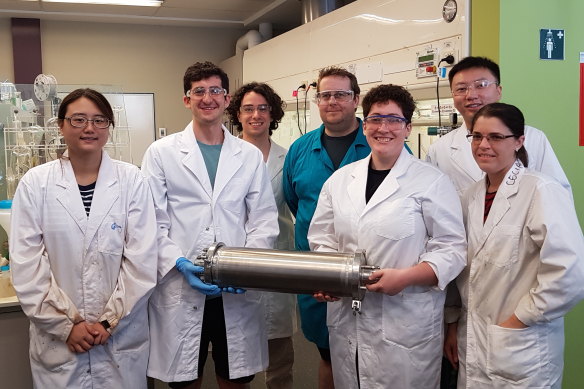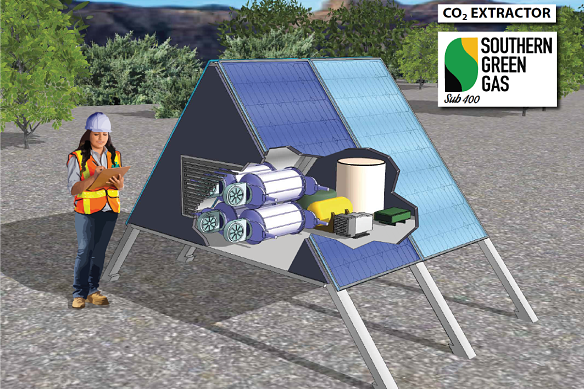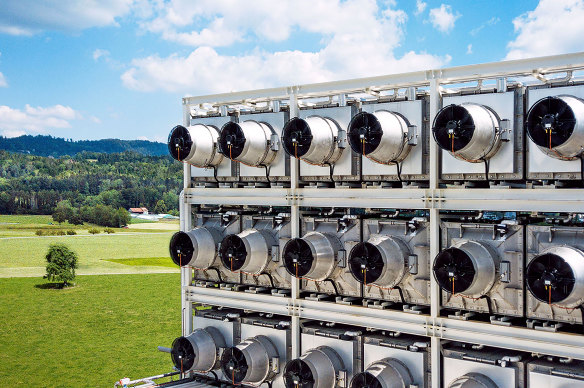This was published 1 year ago
Tech giants back Australia’s first solar-powered carbon capture project
By Angus Dalton
A solar-powered carbon dioxide-trapping device about the size of a two-man tent has secured a $700,000 deal from the world’s tech giants to draw 500 tonnes of carbon from the atmosphere by 2027.
A new Australian company, AspiraDAC (owned by Corporate Carbon), sprang up off the back of the deal, made with global payment company Stripe through its carbon reduction project, Frontier. AspiraDAC said it’s the first solar-powered direct air capture (DAC) technology project with a commercial partner.

The University of Sydney’s Professor Deanna D’Alessandro (far right) with the Sydney Sustainable Carbon student team, holding a DAC module.Credit: Dr Martin van Koeverden
“There’s broad recognition that net zero by 2050 requires not just carbon abatement, but carbon removal at the gigaton scale,” said AspiraDAC executive director Julian Turecek. “What Frontier is doing is helping to facilitate new technologies into that market.”
Stripe’s Frontier project brought together Meta, Alphabet (Google), Shopify and McKinsey & Company to create a US$925 million ($1.36 billion) fund for backing carbon removal technology.
To fulfil the deal, AspiraDAC plans to build about 180 carbon capture modules on an acre of arid land. A bank of DAC devices of that size would, at a cost of at least $1000, remove a tonne of carbon from the atmosphere each day.
That’s less carbon produced by one passenger’s return flight from Sydney to Singapore.

Artist’s impression of a solar-powered direct air capture machine developed by Southern Green Gas and the University of Sydney.Credit: Southern Green Gas
But Frontier only invests in projects it believes could eventually remove carbon at the gigatonne scale for less than U$100 ($148) per tonne.
“Twenty years ago, solar [energy] was very expensive,” said Turecek. “But over the last two decades, it’s come down to become the cheapest form of energy. We believe that direct air capture can follow the same path of technology cost reduction.”
AspiraDAC’s modules were developed by Southern Green Gas and the University of Sydney. Professor Deanna D’Alessandro oversees the university’s Sydney Sustainable Carbon group, which won a $250,000 grant from XPRIZE and Elon Musk’s philanthropic research fund last year to further develop the technology.
“At the heart of the direct air capture process is a porous material. It’s a very highly specific sponge for carbon dioxide,” D’Alessandro said.
Solar panels inbuilt into the machines power both stages of the carbon capture. Fans draw air into the modules, which strip out C02. Once the sponges are saturated, they’re heated, which releases the C02. AspiraDAC would then compress the gas and pump it deep underground at a suitable site, such as a drained oil reservoir.
Critics of carbon capture and storage say it allows oil, gas and coal projects a get-out-of-jail free card to continue mining and burning fossil fuels. Many have failed to meet their carbon-capture goals and often the captured C02 is used to force more oil out of the ground, negating the carbon drawdown.

Climeworks’ Orca direct air capture project in Iceland can capture 4000 tonnes of carbon dioxide per year. Credit: Climeworks
Direct air capture differs from point source capture, which refers to projects that catch emissions directly from a carbon-emitting project such as a coal-fired power plant.
“It’s very important just to distinguish the fact that it does not involve point source capture of carbon dioxide, that it directly addresses the very critical and urgent need to remove historical emissions of human emissions and carbon dioxide from the atmosphere,” D’Alessandro said.
The world’s biggest DAC project, Climeworks’ Orca facility, is perched on an Icelandic lava field and powers its air-sucking fans with geothermal energy. Orca can remove 4000 tonnes of carbon dioxide from the air each year.
Climeworks just announced the construction of another DAC facility in Iceland, Mammoth, that could draw down 36,000 tonnes of carbon a year for permanent storage.
The technology is still prohibitively expensive and currently captures an inconsequential amount of carbon dioxide compared to the billions of tonnes belched by the burning of coal, oil and gas.
But scaled-up direct air capture will be needed to scrub the atmosphere of carbon if we have any chance of restabilising the climate in coming decades, said D’Alessandro. Other carbon capture measures are needed, such as planting trees, but D’Alessandro points out you’d need a forest the size of NSW to negate just two years of Australia’s carbon emissions.
“The Intergovernmental Panel on Climate Change has scientifically demonstrated that we need to be removing at least 10 gigatonnes of carbon dioxide per annum by mid-century,” said D’Alessandro.
The Business Briefing newsletter delivers major stories, exclusive coverage and expert opinion. Sign up to get it every weekday morning.